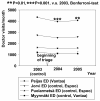Impact of the ABCDE triage on the number of patient visits to the emergency department
- PMID: 20525299
- PMCID: PMC2889933
- DOI: 10.1186/1471-227X-10-12
Impact of the ABCDE triage on the number of patient visits to the emergency department
Abstract
Background: Many Finnish emergency departments (ED) serve both primary and secondary health care patients and are therefore referred to as combined emergency departments. Primary care specialists are responsible for the initial assessment and treatment. They, thereby, also regulate referral and access to tertiary care. Primary health care EDs are easy for the public to access, leading to non-acute patient visits to the emergency department. This has caused increased queues and unnecessary difficulties in providing immediate treatment for those patients who need it the most.
Methods: A face-to-face triage system based on the letters A (patient directly to secondary care), B (to be examined within 10 min), C (to be examined within 1 h), D (to be examined within 2 h) and E (no need for immediate treatment) for assessing the urgency of patients' treatment needs was applied in the main ED in the City of Vantaa, Finland (Peijas Hospital) as an attempt to provide immediate treatment for the most acute patients. The first step was an initial patient assessment by a health care professional (triage nurse). If the patient was not considered to be in need of immediate care (i.e. A-D) he was allocated to group E and examined after the more urgent patients were treated. The introduction of this triage system was combined with information to the public on the "correct" use of emergency services. The primary aim of this study was to assess whether the flow of patients was changed by implementing the ABCDE-triage system in the combined ED. To study the effect of the intervention on patient flow, numbers monthly visits to doctors were recorded before and after intervention in Peijas ED and, simultaneously, in control EDs (Myyrmäki in Vantaa, Jorvi and Puolarmetsä in Espoo). To study does the implementation of the triage system redirect patients to other health services, numbers of monthly visits to doctors were also scored in the private health care and public office hour services of Vantaa primary care.
Results: The number of patient visits to a primary care doctor in 2004 decreased by up to eight percent (340 visits/month) as compared to the previous year in the Peijas ED after implementation of the ABCDE-triage system. Simultaneously, doctor visits in tertiary health care ED increased by ten percent (125 visits/month). ABCDE-triage was not associated with a subsequent increase in the number of patient visits in the private health care or office hour services. The number of ED visits in the City of Espoo, used as a control where no triage was applied, remained unchanged.
Conclusions: The present ABCDE-triage system combined with public guidance may reduce patient visits to primary health care EDs but not to the tertiary health care EDs.
Figures




Similar articles
-
Impact of an ABCDE team triage process combined with public guidance on the division of work in an emergency department.Scand J Prim Health Care. 2015 Jun;33(2):74-81. doi: 10.3109/02813432.2015.1041825. Epub 2015 May 13. Scand J Prim Health Care. 2015. PMID: 25968180 Free PMC article.
-
Impact of the ABCDE triage in primary care emergency department on the number of patient visits to different parts of the health care system in Espoo City.BMC Emerg Med. 2012 Jan 4;12:2. doi: 10.1186/1471-227X-12-2. BMC Emerg Med. 2012. PMID: 22217300 Free PMC article.
-
A Primary Care Emergency Service Reduction Did Not Increase Office-Hour Service Use: A Longitudinal Follow-up Study.J Prim Care Community Health. 2019 Jan-Dec;10:2150132719865151. doi: 10.1177/2150132719865151. J Prim Care Community Health. 2019. PMID: 31354021 Free PMC article.
-
Cost reduction strategies for emergency services: insurance role, practice changes and patients accountability.Health Care Anal. 2009 Mar;17(1):1-19. doi: 10.1007/s10728-008-0081-0. Epub 2008 Feb 28. Health Care Anal. 2009. PMID: 18306043 Review.
-
Urgency classification methods for emergency department visits: do they measure up?Pediatr Emerg Care. 2008 Dec;24(12):870-4. doi: 10.1097/PEC.0b013e31818fa79d. Pediatr Emerg Care. 2008. PMID: 19092571 Review.
Cited by
-
The influence of electronic reminders on recording diagnoses in a primary health care emergency department: a register-based study in a Finnish town.Scand J Prim Health Care. 2021 Jun;39(2):113-122. doi: 10.1080/02813432.2021.1910449. Epub 2021 Apr 14. Scand J Prim Health Care. 2021. PMID: 33851565 Free PMC article.
-
Swedish emergency department triage and interventions for improved patient flows: a national update.Scand J Trauma Resusc Emerg Med. 2011 Dec 8;19:72. doi: 10.1186/1757-7241-19-72. Scand J Trauma Resusc Emerg Med. 2011. PMID: 22151969 Free PMC article.
-
Impact of an ABCDE team triage process combined with public guidance on the division of work in an emergency department.Scand J Prim Health Care. 2015 Jun;33(2):74-81. doi: 10.3109/02813432.2015.1041825. Epub 2015 May 13. Scand J Prim Health Care. 2015. PMID: 25968180 Free PMC article.
-
The effect on the patient flow in a local health care after implementing reverse triage in a primary care emergency department: a longitudinal follow-up study.Scand J Prim Health Care. 2017 Jun;35(2):214-220. doi: 10.1080/02813432.2017.1333320. Epub 2017 Jun 8. Scand J Prim Health Care. 2017. PMID: 28593802 Free PMC article.
-
Financial team incentives improved recording of diagnoses in primary care: a quasi-experimental longitudinal follow-up study with controls.BMC Res Notes. 2015 Nov 11;8:668. doi: 10.1186/s13104-015-1602-1. BMC Res Notes. 2015. PMID: 26559491 Free PMC article.
References
-
- Vertesi L. Does the Canadian Emergency Department Triage and Acuity Scale identify non-urgent patients who can be triaged away from the emergency department? CJEM. 2004;6:337–42. - PubMed
MeSH terms
LinkOut - more resources
Full Text Sources

